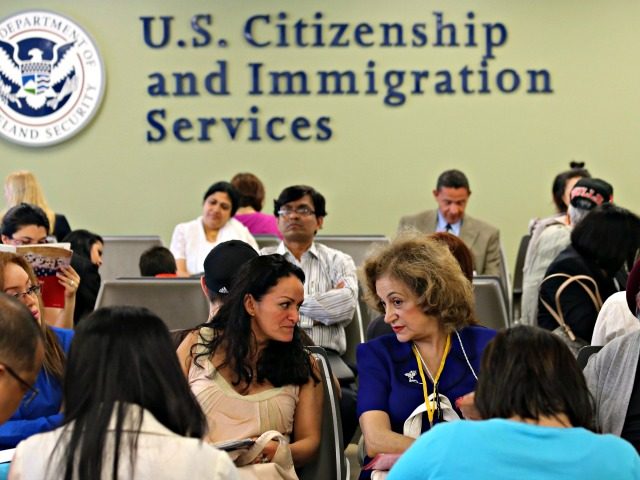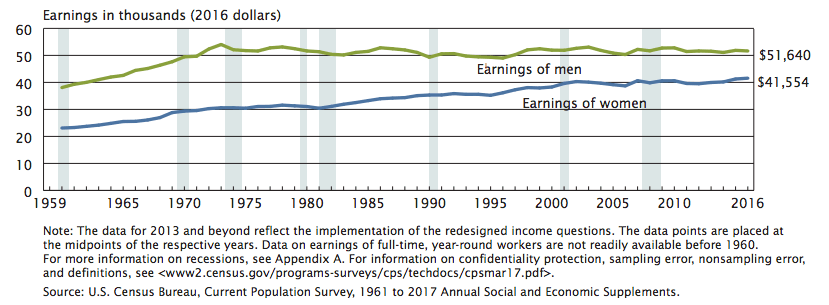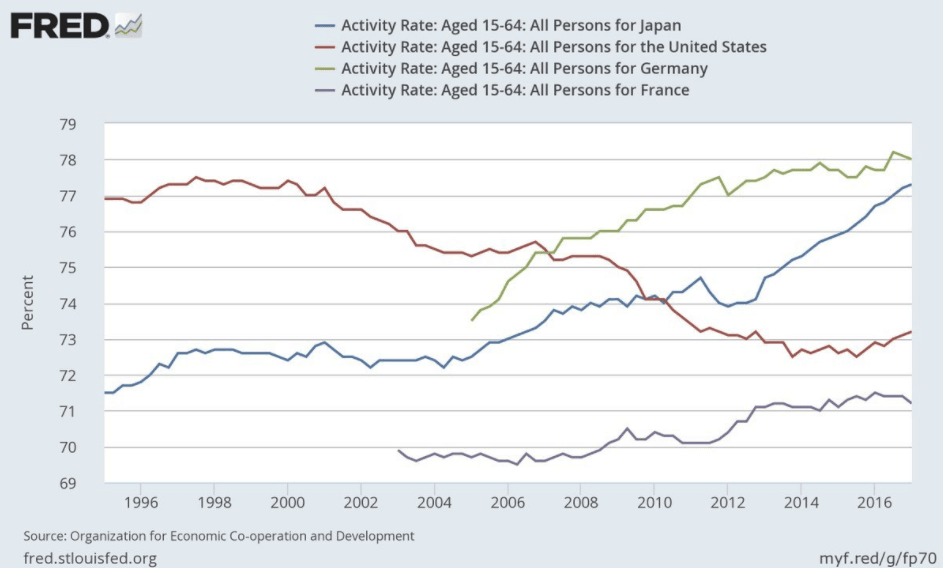Nine million working-age men have been pushed out of the workforce by the federal government’s salary-cutting economic strategy, says a former economist for former President Barack Obama.
The admission comes as some legislators in Congress renew their push for a huge ‘dreamer’ amnesty that would increase the number of low-wage foreign workers who can take U.S. jobs.
The nine million number comes from a new op-ed by Jason Furman, a top economic advisor to Obama. Without mentioning cheap-labor labor, Furman writes in the Wall Street Journal:
The U.S. has experienced a record 86 consecutive months of job growth. But some nine million men of prime age—that is, between 25 and 54—still are not working. Most have given up looking for jobs. Helping these men get back into the workforce should be a leading public-policy priority …
The largest issue facing American men is not that they are rewarded for remaining in a recliner, but that they cannot find rewarding work. The bulk of the decline in employment has been for men with a high-school diploma or less, who have seen their employment rates fall from 97% in 1964 to 83% today. This has coincided with a decline in their relative wages: High-school grads in the 1970s earned two-thirds what their college-educated counterparts took home. Today it’s around half.
Reversing the withdrawal of men from the workforce will require rising wages. This can be achieved by improving the skills of workers through education and training and improving the bargaining power of workers to raise wages. Direct steps like expanding the earned-income tax credit could also make a difference, though the policy is absent from the current tax-reform bill—despite Speaker Paul Ryan’s past support for it.
Furman carefully excludes immigration as a reason for Americans’ low wages, but his comments come amid a renewed push for amnesty by Congress.
The push comes from Democrats, including Sen. Richard Durbin, and also from some business-first Republicans, including South Carolina Sen. Lindsey Graham and North Carolina’s Sen. Thom Tillis.
This week, for example, the Senators have been meeting to develop an amnesty plan that would offer token border-security measures against illegal immigration in exchange for legalizing more than 3 million illegals — plus their future chain-migration relatives.
Americans’ wages grew rapidly until the 1965 immigration rewrite expanded the inflow of foreign workers after the 1975 oil-price shock, according to data provided by the Census Bureau in 2017. Since then, wages have been flat, but that stagnation has been partly hidden by the rising quality and declining cost of many items, including coffee, entertainment, and Internet services.
Amid the wage stagnation and the government-managed huge inflow of foreign workers, the percentage of working-age Americans who are not in the workforce has fallen below the work rates in Japan and Germany.
Business groups say many Americans have quit the labor market because of easy welfare rules.
Furman says federal welfare policy is not pulling the nine million American men out of the job market, noting that ” the fraction of prime-age men receiving any federal cash assistance—including disability insurance and other cash payments—has fallen to 10% in 2016 from 20% in 1975. ”
House Speaker Paul Ryan recently admitted that many Americans have been pushed to the sidelines, as he sketched out a plan for welfare reform in 2018.
“When we have tens of millions of people right here in this country falling short of their potential, not working, not looking for a job, or not in school getting a skill to get a job, that’s a problem,” Ryan said December 14. He said:
Let’s change our welfare laws so we push and pull people out of poverty into the workforce … we’re going to be able to create an economy that produces good family-supporting jobs, higher wages, that will be there for people who are stuck in poverty and welfare to go to.
Despite his press-conference focus on Americans, in 2015 and 2017 Ryan successfully pushed for an expansion of the H-2B program, which allows foresty and landscaping companies to import foreign workers for seasonal jobs. Ryan’s cheap H-2B labor helps the companies cut their seasonal and full-year payrolls, but cuts average pay and reduces the ability of sidelined Americans to take seasonal jobs.
Immigration experts fear Ryan will again try to expand the H-2B program in the 2018 budget talks, which are due for completion in January.
Both Republicans and Democrats are under intense business pressure to grow economic consumption and Wall Street’s stock values by importing foreign consumers and workers, instead of by growing Americans’ productivity and wages.
In September 2017, for example, the business-funded Hamilton Project think-tank debated why Americans’ wages remain flat — but dismissed the impact of the federal government’s policy of annually importing roughly one immigrant consumer/worker for every four Americans who turn 18 each year.
The event was overseen by former U.S. Treasury Secretary Robert E. Rubin, who helped found the Hamilton Project think-tank. He pushed a policy of immigration-boosted economic growth in place of immigration-restricted salary growth. He said:
If we are going to put in place a policy agenda that addresses [national economic] growth and addresses wage stagnation or sluggishness, effectively, it has got to start with a clear understanding of the facts over the last several decades, and a clear understanding of the causes … My own view as to causation is that it is a combination of the factors I have just mentioned — technological development, globalization, and decline of labor unions on the one hand, and also the abject failure of our political system to put in place an effective, inclusive growth agenda.
Subsequent panelists at the event, including Furman, dismissed the role of federal immigration policy.
Four million Americans turn 18 each year and begin looking for good jobs in the free market.
But the federal government inflates the supply of new labor by annually accepting 1 million new legal immigrants, by providing work-permits to roughly 3 million resident foreigners, and by doing little to block the employment of roughly 8 million illegal immigrants.
The Washington-imposed economic policy of mass-immigration floods the market with foreign labor, spikes profits and Wall Street values by cutting salaries for manual and skilled labor offered by blue-collar and white-collar employees. It also drives up real estate prices, widens wealth-gaps, reduces high-tech investment, increases state and local tax burdens, hurts kids’ schools and college education, pushes Americans away from high-tech careers, and sidelines at least 5 million marginalized Americans and their families, including many who are now struggling with opioid addictions.
The cheap-labor policy has also reduced investment and job creation in many interior states because the coastal cities have a surplus of imported labor. For example, almost 27 percent of zip codes in Missouri had fewer jobs or businesses in 2015 than in 2000, according to a new report by the Economic Innovation Group. In Kansas, almost 29 percent of zip codes had fewer jobs and businesses in 2015 compared to 2000, which was a two-decade period of massive cheap-labor immigration.
Because of the successful cheap-labor strategy, wages for men have remained flat since 1973, and a large percentage of the nation’s annual income has shifted to investors and away from employees.



COMMENTS
Please let us know if you're having issues with commenting.